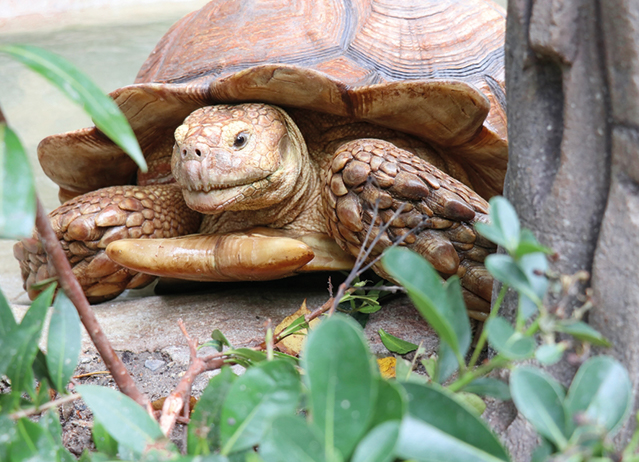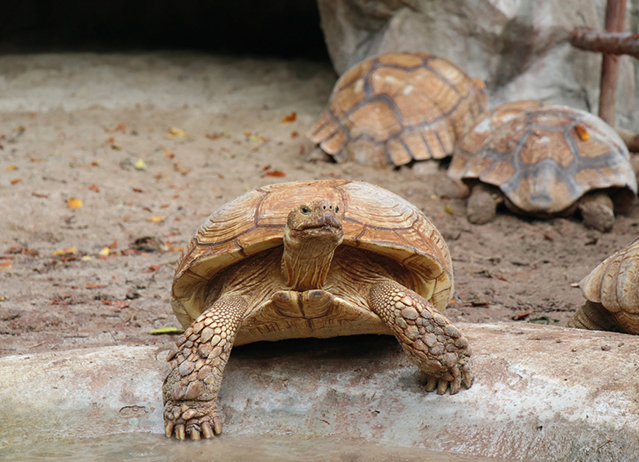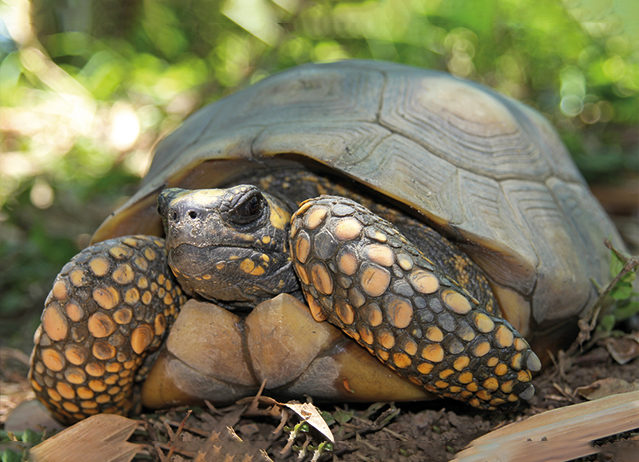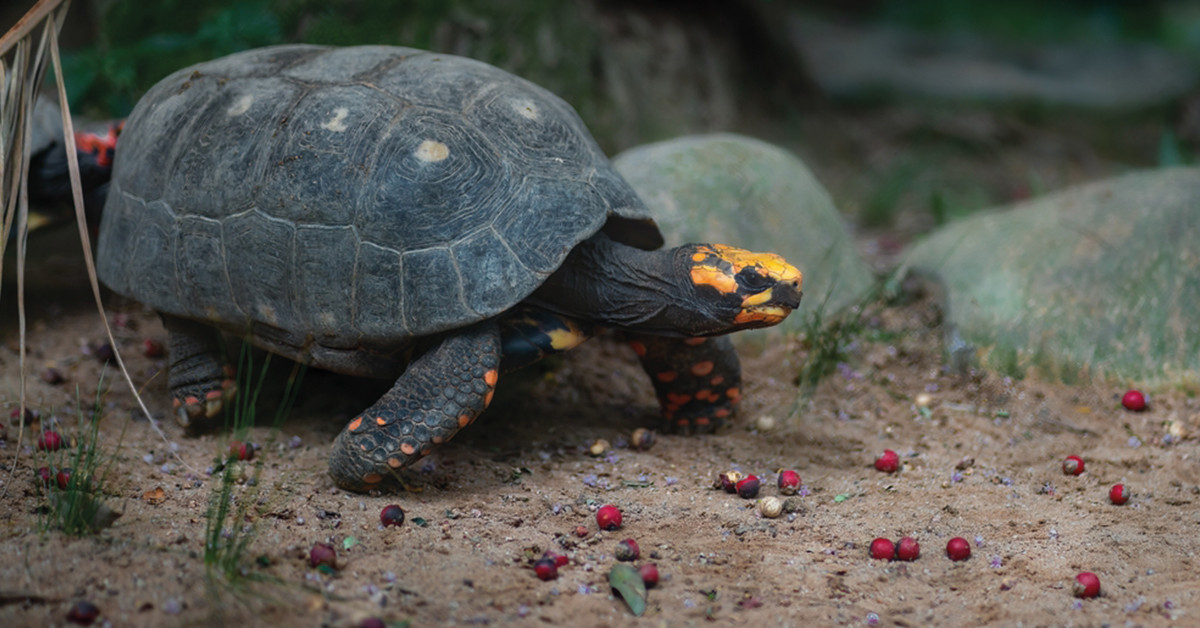About Yellow-Footed Tortoise
| Size | Medium to Large |
| Length | 40-94 cm |
| Type | Terrestrial |
| Food | vegetables, fruits, commercial pelleted tortoise food, Leafy greens |
| Lifespan | 50 Years |
| Difficulty of Care | Low Maintenance |
| Comparable Breeds | Red-Footed Tortoise |
The yellow-footed tortoise is a medium to large from South America, mainly inhabiting the Amazon rainforest and surrounding tropical areas. One of its main distinguishing characteristics is yellow or orange scales on its front legs, head, and tail, with a highly domed dark shell and lighter yellowish markings on its scutes. Yellow-footed tortoises are herbivorous, mainly feeding on fruits, flowers, leaves, and small animals sometimes. They are relatively slow-moving tortoises that live in the wild for about decades and help in seed dispersal through their broad dieting behavior. They are also one of the species that feature in reptile conservation efforts because of habitat loss due to pressure and the trade of such reptiles in the illegal pet trade.
Yellow Foot Tortoise General Info
Like the Red-Footed Tortoise, the Yellow-Footed Tortoise is among the pet trade’s most common and popular tortoise breeds. The characteristics that make these animals personable, attractive, and hardy make them a good choice, even for beginners.
If you do decide that you’d like to bring a Yellow-Footed Tortoise into your family, then make sure to buy one from a reputable breeder who can guarantee that the animal was born in captivity. That way, you’ll allow its threatened wild populations to thrive.
The Yellow-Footed Tortoise is deemed one of the most popular and loved tortoise breeds kept in the pet trade.

Origin and Natural Habitat
Geographical Distribution
The Yellow Footed Tortoise belongs to the species Geochelone denticulata and occupies a long, intensively biodiverse portion of South America. It primarily dwells in dense, lush parts of the rainforest regions in countries like Brazil, Guyana, and Venezuela. In essence, tortoises prefer dwelling on land areas kissed with humidity to the earth and where deep canopies give shade along with a patchy mosaic of brightness. These creatures, being integral parts of the South American ecosystem, can indicate a lot about the health and vigor of the rainforest.
Growing interest in the world of exotic pets has heightened interest in the habitats of Yellow Foot Tortoise. While geographical distribution speaks volumes to paint vivid pictures of the tropical realms, it also serves as a reminder of habitats under threat from deforestation and sprawling urban development.
Any visitor to the very center of South America, where one might hear many sounds and a variety of shades of green, might catch a glimpse of these characteristic tortoises; they have been recognized as the icon that characterizes the great diversity of biodiversity that exists here. Now, more than ever, conservation can mean protecting natural areas that compose a part of the Yellow-Footed Tortoise’s territory so that future generations will be treated to the beauty of seeing them in the wild as well.
Environment Preferences
The Yellow Footed Tortoise is a charismatic denizen of the South American rainforest, with marked environment preferences, and its well-being and longevity are strongly linked to specific environmental conditions. It is naturally adapted to warm, humid, and close forests of Brazil, Venezuela, and Guyana, among others, and it thrives under conditions with ample shade and constant moistness.
It provides both food and camouflage for them on the leaf-littered floor of the rainforest, protecting them from potential predators. Sun-dappled clearings give them their favorite basking spots to maintain their body temperature. When considering an enclosure for a captive-footed Footed Tortoise, it’s important to emulate those same conditions—high humidity, access to basking spots, and a diet rife with local fruits, flowers, and leaves.
Essentially, replicating this South American rainforest, along with its warmth and humidity, is the way by which to make certain that a Yellow-Footed Tortoise is both happy and healthy.
Size & Growth
Although the Yellow Foot Tortoise is very well known for its bright, sun-kissed feet, these tortoises have acquired another reputation: size and growth. The average length for this tortoise, native to the lush rainforests of South America, is 12 to 16 inches in adulthood. From palm-sized hatchlings, they grew year by year into a sturdy, defined shell that speaks of age and health.
Their growth rate is affected by many factors, such as good nutrition, suitable housing states, and their genetics. A well-cared-for yellow-footed tortoise keeps up in a climate that mimics the environment of its native habitat, with space to roam and fed a diet rich in calcium and vitamins to reach their maximum potential. Knowing such a tortoise’s growth curve is especially useful to enthusiasts and breeders. It offers insights into their care needs, lifespan, and health considerations.
Whether you’re thinking of bringing one of these magnificent creatures into your life or want to know the size for that stature, dive deep into understanding their growth—it’s as interesting as those sunlit feet!

Related: Eastern Box Turtle
Dietary Needs
The Yellow Footed Tortoise typifies the luxuriant rain forests of South America and has a distinctive, varied diet, which is instrumental to their health and their brilliant colors. In the wild, their diet is predominantly vegetarian, with an assortment of fruits, leaves, and flowers on the menu. Although the diet should contain a lot of leafy greens like kale, dandelion, and collard greens, these, too, can be made a staple. But for these creatures to retain their verve and the bright yellow foot marking, the diet should be completed with a host of other fruits like papayas, mangoes, and melons. It then makes it interesting for the tortoise and an eager appetite can be expected for every meal.
Edible flowers and calcium-rich foods for good shell development must not be forgotten. In the wild, there is the availability of wild-caught invertebrates in the diet, while high-protein foods must be kept at a minimum in captivity. Proper hydration is key to their digestive system; freshwater should always be available. Regularly changing the food also ensures a balanced diet.
Remember, these, like us, also need a varied diet to stay healthy. All that is done by sticking to such dietary guidelines for your Yellow yellow-footed tortoise will be to have a healthy animal that exudes health as well as those very yellow sunny feet.
Housing Recommendations
The Yellow Footed Tortoise thrives in housing that most closely resembles their native habitat the lush, humid rainforests of South America. This is information critical to anyone who would like to set up a haven for such wonderful creatures.
From first-time tortoise keepers to seasoned enthusiasts in reptilian matters, the details about housing will directly affect both the general health and happiness of the tortoise. Foremost in their needs is space. Their wild brothers and sisters roam widely, and in captivity, they’ll want plenty of space to explore and forage. The ideal enclosure is at least 10×10 feet in area. This enclosure should contain Sunny areas and shade, and the floor should resemble the forest floor – a mix of grass, leaf litter, and soft earth in which they can burrow.
It is essential to keep the temperature between 75-90°F with heated retreats or basking areas in colder climates. Proper humidity should be maintained, around 70-80%. This could be achieved with misters, daily spritzing, or shallow water trays.
This oftentimes overlooked factor involves the provision of retreats or shelters. Having various hideaways, be it leaf canopies or wooden shacks, would further reinforce the tortoise’s perception of its safety. These places, in addition to providing refuge in times of danger, also provide the tortoise with a place to cool off during the hottest temperatures.
Add logs, boulders, and munchable flora to spice things up, mimicking the challenges they face in their wild habitat.
In summary, if one is going to truly take care of a Yellow Footed Tortoise, the goal should be to simulate their wild environment. With commitment, careful planning, and a touch of imagination, it is possible to create a piece of heaven that will give them a long and satisfying life in captivity.
Care Requirements
The yellow-footed tortoise is mainly herbivorous. Their diet will chiefly comprise fruits and green leafy plants, including endives, clover, and dandelion, to name but a few.
You can offer your pet a salad mix of greens, vegetables, and fruits, as well as flowers, daily or every other day. Some options that are good to include are collard greens, mustard greens, watercress, escarole, kale, romaine, squash, carrots, pumpkin, zucchini, mango, melon, kiwi, papaya, cantaloupe, and hibiscus.
Not much of this tortoise’s diet should be made up of animal protein. However, you can give him a commercial tortoise diet about every three weeks or so.
Behavior
The Yellow Foot Tortoise is a shy animal, and they will not enjoy being handled. They’ll quite often retreat into their shells. However, some animals may be tame and outgoing, especially those that are captive-bred and raised.
Common Health Problems
Known for their radiant limbs and rather docile nature, the Yellow-Footed Tortoise stands out as the reptilian wonder. Nevertheless, just like any other animal, they are not free from health vulnerabilities either. One of the important health issues they would easily face would be respiratory infections. They easily die from breathing difficulties in a room with improper humidity or temperature.
As such, their environment must be as humid as the rainforests they originated from in South America. Another ghost that faces these tortoises is the disorder of the shell. Poor food or dirty surroundings can cause the shell to rot or pyramid, a condition where the shell’s scutes grow excessively upwards.
External and internal parasites are also a danger. If cared for improperly, it is not unlikely to see Yellow yellow-footed tortoises fighting internal worms or external mites and ticks. Next, there is the risk of metabolic bone disease that emanates from a lack of calcium or Vitamin D in their diet. This weakens their shell and bone structure and causes deformities in these areas. Finally, much like many tortoises, they sometimes have overgrown beaks, impeding their ability to eat. These animals require frequent medical checkups, a clean habitat, and a balanced diet for them to grow well.
So any person who is interested in keeping this tortoise as a pet needs to be very aware of these common health issues of the Yellow-Footed Tortoise. The more we know, the more we will be able to help these wonderful creatures to live a healthy and rewarding life.

Mating Habits
| Reproduction Season | year-round |
| Incubation Period | 105-202 days |
| Independent Age | at Birth |
| Female Name | Female |
| Male Name | Male |
| Baby Name | hatchling |
| web.animal_clutch_size | 6-16 eggs |
3 Little Known Facts About Yellow-Footed Tortoise
Here are three little-known facts about the yellow-footed tortoise:
- Unique Vocalization: Yellow-footed tortoises are vocal when reproducing, creating sounds similar to a low rumble during mating season.
- Color-Changing Shell: It becomes dark with age and the presence of environmental factors. Due to this reason, yellow-footed tortoises tend to camouflage with the densely covered shaded floor of forests due to their living location in the tropics.
- Water-Loving Behavior: They, however, like many tortoises unlike many tortoises, appreciate shallow water; this makes them get adequate moisture on the skin coupled with keeping their bodies cooler.

